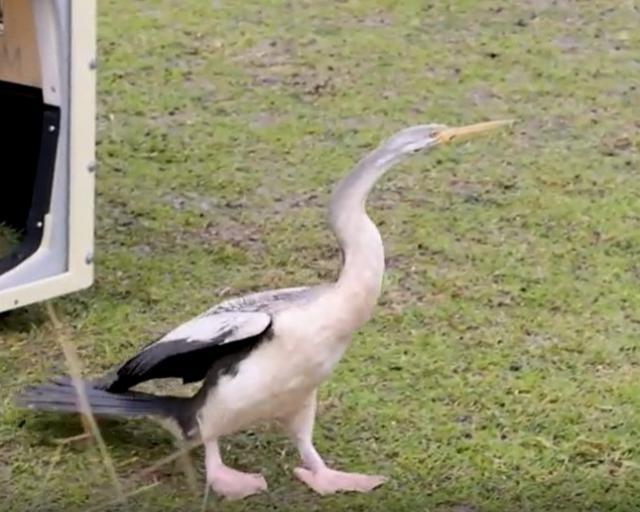
Darter birds are known for their long, snake-like beaks, which can spear their underwater prey at lightning speed.
Normally, these native birds catch Carp and Bream, however one young bird had to be rescued after catching a deadly meal dangling on a sharp hook.
Melbourne Zoo’s Marine Response Unit responded to a call from Wildlife Victoria about a darter, whose mouth was pinned open by fishing line connected to a plastic fish-lure wrapped around its beak.
The rescue mission took three hours of kayaking through reeds at Lillydale Lake, before the team was able to safely free the stealthy bird from the plastic line cutting into its neck and transport it back to Melbourne Zoo for veterinary care to remove a fishing hook embedded in its shoulder.
The Marine Response Unit’s David Coy said fishing material is a huge issue for these birds.
“Unfortunately, this darter had fishing line wrapped around its serrated beak and neck, with the hook lodged deep into its shoulder,” Mr Coy said.
“This case is one the Marine Response Unit has seen dozens of times over the years, as these birds can mistake anything from fishing tackle to baby socks for food.”
Melbourne Zoo veterinary team removed the fishing hook under anaesthetic and gave the bird a full health check before it was returned to Lilydale.
Mr Coy said it is satisfying to successfully rehabilitate and release entangled birds, as many aren’t so lucky.
“The darter was hesitant to go back into the water at first, but soon he was freely flapping his wings and soaring over the lake once more,” Mr Coy said.
“It’s a stark reminder for Victorians to keep our wetlands free from rubbish and protect our precious wildlife.”
Australian Darters, often referred to as snakebirds, are found in Australia’s shallow wetlands. The large, slim waterbirds are characterised by their long neck, sharp pointed bill, and long, rounded tail. Male birds are dark brown with glossy black and white wings, while females are greyish-brown with a white neck stripe.
Each year, Melbourne Zoo’s Marine Response Unit receives thousands of calls about marine wildlife entangled in waste, including fishing gear. Zoos Victoria works with the Victorian Fisheries Authority to install ‘Seal the Loop’ bins where anglers can dispose of any unwanted fishing gear.
Anyone who sees a marine animal in distress should call the Melbourne Zoo Marine Response Unit on 1300 245 678.







